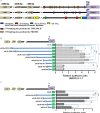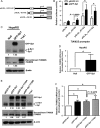Sp1-mediated ectopic expression of T-cell lymphoma invasion and metastasis 2 in hepatocellular carcinoma
- PMID: 26763486
- PMCID: PMC4799941
- DOI: 10.1002/cam4.611
Sp1-mediated ectopic expression of T-cell lymphoma invasion and metastasis 2 in hepatocellular carcinoma
Abstract
T-cell lymphoma invasion and metastasis 2 (TIAM2) is a neuron-specific protein that has been found ectopically expressed in hepatocellular carcinoma (HCC). Results from clinical specimens and cellular and animal models have shown that the short form of TIAM2 (TIAM2S) functions as an oncogene in the tumorigenesis of liver cancer. However, the regulation of TIAM2S ectopic expression in HCC cells remains largely unknown. This study aimed to identify the mechanism underlying the ectopic expression of TIAM2S in liver cancer cells. In this report, we provide evidence illustrating that Sp1 binds directly to the GC box located in the TIAM2S core promoter. We further demonstrated that overexpression of Sp1 in HepaRG cells promotes endogenous TIAM2S mRNA and protein expressions, and knockdown of Sp1 in 2 HCC cell lines, HepG2 and PLC/PRF/5, led to a substantial reduction in TIAM2S mRNA and protein in these cells. Of 60 paired HCC samples, 70% showed a significant increase (from 1.1- to 3.6-fold) in Sp1 protein expression in the tumor cells. The elevated Sp1 expression was highly correlated with both TIAM2S mRNA and protein expressions in these samples. Together, these results illustrate that Sp1 positively controls TIAM2S transcription and that Sp1-mediated transcriptional activation is essential for TIAM2S ectopic expression in liver cancer cells.
Keywords: Ectopic activation; GC box; Sp1; TATA-less gene; TIAM2S.
© 2016 The Authors. Cancer Medicine published by John Wiley & Sons Ltd.
Figures





References
-
- Chen, J. S. , Su I. J., Leu Y. W., Young K. C., and Sun H. S.. 2012. Expression of T‐cell lymphoma invasion and metastasis 2 (TIAM2) promotes proliferation and invasion of liver cancer. Int. J. Cancer 130:1302–1313. - PubMed
-
- Zhao, Z. Y. , Han C. G., Liu J. T., Wang C. L., Y. Wang , and Cheng L. Y.. 2013. TIAM2 enhances non‐small cell lung cancer cell invasion and motility. Asian Pac. J. Cancer Prev. 14:6305–6309. - PubMed
-
- Saraon, P. , Jarvi K., and Diamandis E. P.. 2011. Molecular alterations during progression of prostate cancer to androgen independence. Clin. Chem. 57:1366–1375. - PubMed
-
- Beishline, K. , and Azizkhan‐Clifford J.. 2015. Sp1 and the ‘hallmarks of cancer’. FEBS J. 282:224–258. - PubMed
Publication types
MeSH terms
Substances
LinkOut - more resources
Full Text Sources
Other Literature Sources
Medical
Miscellaneous

